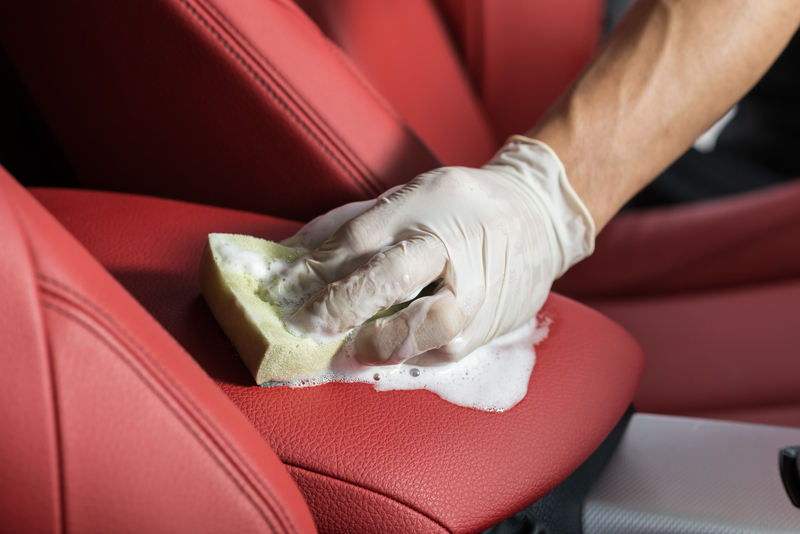The Path to Clean: An Essential Guide for Enamel Tray De-greasing
Posted on 17/08/2025
The Path to Clean: An Essential Guide for Enamel Tray De-greasing
Enamel trays are renowned for their durability, non-reactive surface, and timeless appeal in kitchens, laboratories, and healthcare facilities. Despite these advantages, the build-up of grease and organic residue is a persistent challenge. Proper de-greasing of enamel trays is not just a matter of appearance or hygiene; it also preserves the functionality and lifespan of these indispensable items.
This comprehensive guide will walk you through the path to a spotless, grease-free enamel tray, encompassing the science behind enamel, the necessity of regular tray cleaning, safe and effective degreasing methods, maintenance tips, and advanced techniques for challenging situations. By following these best practices, you can ensure your enamel trays remain in top condition for years to come.

Understanding Enamel Trays: Composition and Common Uses
Enamel trays are made from metal--often steel or iron--coated with a layer of vitrified (glass-like) enamel. This powerful coating endows the trays with:
- Corrosion resistance: Protects against rust and chemical damage.
- Non-porous surface: Prevents absorption of stains, odors, and bacteria.
- High-heat tolerance: Suitable for sterilization and baking applications.
Common uses for enamel trays include:
- Medical and dental instrument sterilization
- Food preparation and serving trays
- Baking sheets in both home and professional kitchens
- Chemical-resistant trays in laboratories
Why Does Grease Build Up on Enamel Trays?
Despite their non-stick reputation, enamel trays accumulate grease from animal fats, vegetable oils, and organic residues during routine use. Over time, repeated exposure to heat, inefficient cleaning practices, or allowing fats to cool and solidify leads to stubborn, sticky films. These residues can:
- Harbor bacteria and pathogens
- Cause unpleasant odors and tastes
- Reduce the tray's effectiveness and lifespan
The Importance of Proper Enamel Tray De-greasing
Effective degreasing of enamel trays isn't just about appearances--it impacts:
- Hygiene and safety: Organic residues attract bacteria and promote cross-contamination.
- Food and experiment integrity: Old grease can alter flavors and spoil chemical reactions.
- Enamel preservation: Prolonged grease contact can degrade or discolor the enamel surface.
- Regulatory compliance: In healthcare, foodservice, or laboratories, cleanliness is required by law.
How do Grease and Enamel Interact?
The smooth, glossy finish of enamel naturally repels many substances, but persistent exposure causes fats and oils to polymerize and adhere--sometimes entering hairline cracks in aging trays. This makes routine enamel tray degreasing vital.
Step-by-Step Guide: How to Clean Grease from Enamel Trays
1. Evaluate the Tray's Condition
Begin by examining the tray for:
- Heavy grease buildup: Thick, sticky or solidified patches
- Burnt-on residues: Black or brown baked-on marks
- Cracks or chips: Exposed metal underneath reduces protection
2. Choose Appropriate Degreasing Agents
The best enamel tray degreasing agents are those that cut through grease effectively without harming the enamel:
- Mild dish soap - Gentle, effective against light grease
- Baking soda - A natural abrasive for lifting stuck-on grime
- Vinegar - Helps dissolve fats but should be rinsed off quickly (avoid soaking for too long)
- Warm water - Essential for melting fat and softening residues
AVOID: Scouring pads, steel wool, or strong alkalis/acids as these can scratch and erode enamel coating.
3. The Degreasing Process (Routine Cleaning)
- Remove loose debris: Use a spatula or plastic scraper to gently lift excess food or grease.
- Soak the tray: Fill the tray with hot (not boiling) water and add a few drops of mild dish soap.
- Let it sit: Allow the tray to soak for 10-30 minutes. Hot water loosens the grease and softens residues.
- Gently scrub: Use a soft sponge or non-abrasive scrubber to wipe away the grease. For stubborn spots, sprinkle baking soda on the sponge for extra cleaning power.
- Rinse thoroughly: Any cleaning residue left behind can affect taste or lab results. Rinse under running water, ensuring all soap is washed away.
- Dry immediately: Wipe with a lint-free cloth or let air-dry to prevent water spots and maintain shine.
4. Tackling Stubborn or Burnt-on Grease
Strong, persistent stains call for enhanced methods. Try the following techniques:
- Baking Soda Paste: Mix baking soda and water into a thick paste. Apply directly, let sit for 20-30 minutes, and wipe away.
- Vinegar and Baking Soda Reaction: Sprinkle baking soda over the greasy area, then spray or pour a small amount of vinegar. Let the fizz help lift the scum, then rinse well.
- Specialized Enamel Cleaners: Look for products specifically labeled as safe for enamel cookware and trays.
- Repeat as Necessary: For severe buildup, several rounds of soaking and gentle scrubbing may be required.
Advanced Enamel Tray Grease Removal Techniques
Enzyme-Based Degreasers
Enzyme cleaners break down organic molecules, including fats and proteins, making them ideal for tough residue. Choose enzyme formulas safe for enamel and follow instructions for dwell time before rinsing thoroughly. These are especially useful in healthcare or lab environments where organic residues can be diverse and persistent.
Dishwasher Use (If Tray Size Permits)
- Check if your enamel tray is dishwasher safe. While many are, trays with hand-painted elements or decorative rims may not be suitable.
- Load soiled side facing spray jets for best results.
- Use a mild detergent and select the "pots & pans" cycle for heavily greased trays.
- Check for chips post-wash and dry thoroughly.
Steam Cleaning
For eco-friendly, chemical-free degreasing, consider a handheld steam cleaner. Direct a jet of steam onto the grease, then wipe clean with a microfiber cloth. This is especially helpful for removing burnt oils and restoring shine.
Professional Cleaning Services
For commercial kitchens, medical, or laboratory settings where deep, frequent cleaning is a must, outsourcing to a professional tray cleaning provider can be cost-effective and ensures regulatory compliance. They employ industrial-grade, enamel-safe degreasing methods that are difficult to replicate at home.
Maintaining Enamel Trays: Prevention and Care Tips
Once your enamel tray is grease-free, a few preventive measures can help keep it that way:
- Clean promptly: Address spills and splatters immediately after use to prevent grease from hardening.
- Avoid metal utensils: Use wood or silicone to prevent scratches where grease can accumulate.
- Use liners: For trays used for baking, parchment paper or silicone mats drastically reduce grease contact.
- Store dry: Keep trays dry to inhibit microbial growth and water marks.
- Periodic deep cleaning: Schedule a monthly or quarterly deep clean, especially if the tray is heavily used.
What Not to Do
- Never use bleach or harsh alkalis--strong chemicals damage the enamel coating.
- Avoid abrasive cleaning pads: Steel wool, metal brushes, and coarse scouring powders scratch enamel and speed up wear.
- Don't leave trays soaking overnight: Extended exposure to water can cause crazing or cracks in the enamel, especially on older trays.
Common Mistakes to Avoid in Enamel Tray Degreasing
When degreasing an enamel tray, beware of these pitfalls:
- Scraping aggressively: Chipping or cracking enamel exposes metal, leading to rust and further grease adherence.
- Ignoring rinsing: Soap or cleaner residue may react during next use or interfere with tray function.
- Mixing chemicals: Never combine cleaning agents (e.g., bleach and vinegar), which can be dangerous and degrade enamel.
- Heating while dirty: Baking or sterilizing trays before cleaning hardens grease and makes removal more difficult.
Eco-friendly and Safe Enamel Tray Degreasing Solutions
Conscious of both surface safety and environmental impact, use these natural alternatives:
- Lemon juice: Natural citrus oils cut through light grease and leave a fresh scent.
- Castile soap: A gentle, plant-based soap effective for routine cleaning.
- Hydrogen peroxide and baking soda: For disinfecting and stain removal in one step.
Always perform a spot test before extended application to ensure new solutions do not discolor or damage the tray.

Frequently Asked Questions About Enamel Tray Degreasing
How often should I degrease my enamel tray?
After every use is best for culinary or laboratory settings. For domestic or infrequent use, clean promptly after visible grease accumulates and deep clean monthly.
What should I do if the enamel is chipped?
Stop using chipped enamel trays for food or chemical handling as the exposed metal can rust and contaminate contents. Small chips may be repairable with food-safe enamel touch-up kits; otherwise, consider replacing the tray.
Are commercial oven cleaners safe for enamel trays?
Some commercial oven cleaners contain chemicals that are too harsh for enamel. Always check the label for enamel-safe products, and never use caustic soda or lye on enamel surfaces.
Can I use my enamel tray in a self-cleaning oven cycle to de-grease?
No--self-cleaning cycles reach extremely high temperatures which can cause enamel to crack or discolor. Stick to manual cleaning methods detailed above.
Conclusion: The Clear Path to Spotless, Grease-free Enamel Trays
Mastering the art of enamel tray degreasing is about pairing knowledgeable technique with conscientious maintenance. Prompt, gentle cleaning, mindful product use, and regular upkeep ensure your enamel trays stay pristine, hygienic, and fit for their essential job. Whether for food service, laboratory, or medical use, the path to clean starts--and continues--with smart, evidence-backed habits.
For more tips on care, cleaning methods, and maintaining your enamelware's longevity, bookmark this guide and return whenever you need expert advice for degreasing your enamel trays!
```



